In a tradition which dates back nearly 800 years, on the Solemnity of the Most Holy Body and Blood of Christ (Corpus Christi), the faithful at Parishes throughout the Diocese of Venice celebrated the Real Presence of Jesus Christ on June 2, 2024.
Eucharistic processions throughout the Diocese of Venice gave a “public witness of our faith in the Most Blessed Sacrament,” a true celebration of the Eucharist and the Real Presence of Our Lord.
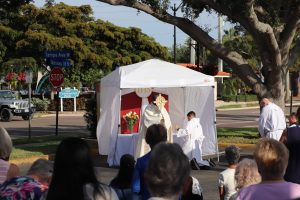 At Our Lady of Light Parish in Fort Myers, the Pastor, Father Hugh McGuigan, Oblate of St. Francis de Sales, explained the importance of the Solemnity as a “celebration of the fulfillment of God’s great desire to be one with His people – to establish an everlasting covenant with us – a covenant which guarantees our forgiveness and reconciliation.”
At Our Lady of Light Parish in Fort Myers, the Pastor, Father Hugh McGuigan, Oblate of St. Francis de Sales, explained the importance of the Solemnity as a “celebration of the fulfillment of God’s great desire to be one with His people – to establish an everlasting covenant with us – a covenant which guarantees our forgiveness and reconciliation.”
Following Mass, Father McGuigan invited the faithful to take a “walk with Christ.” The Corpus Christi procession began with the placement of a consecrated host in the monstrance (a sacred vessel that displays the sacred host to the faithful). After a brief time for all to pray before the Most Holy Eucharist, the procession, led by altar servers carrying candles and an incenser, advanced out of the Church sanctuary.

Because of the heat, the procession led out into the courtyard and into the Parish Hall. At three locations along the route there were decorated altars where the monstrance was placed and, after a period of prayer, which included a Gospel reading and intercessions, the people were blessed. In this way the Church shows that Christ, here among us, walks with us on our pilgrimage to heaven. A Eucharistic Procession is not only a tradition in the Catholic Church but is a public witness of our faith in the Blessed Sacrament in the community.
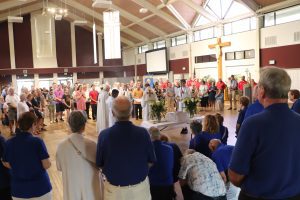
Processions, like the one at Our Lady of Light, and elsewhere throughout the Diocese, took on a special meaning during a time of National Eucharistic Revival and teaching leading up to the July National Eucharistic Congress in Indianapolis. There, tens of thousands of Catholics will gather to celebrate the National Eucharistic Revival, a three-year movement by the U.S. Bishops to answer the call of Jesus Christ to return to the source and summit of Our Faith – the Real Presence in the Holy Eucharist. Bishop Frank J. Dewane will be leading a group of pilgrims to the Congress.
The National Eucharistic Revival was launched as an initiative of the U.S. Catholic Bishops in 2022. Here in the Diocese of Venice, at the direction of Bishop Dewane, several major events have taken place, including a 2023 Diocesan Eucharistic Congress and Youth Rally, a 2024 Diocesan Eucharistic Conference, as well as many more Most Blessed Sacrament-themed Parish initiatives. These events drew thousands together to set hearts afire in celebration of the Most Blessed Sacrament.





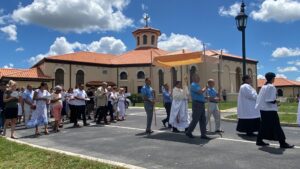


 After the celebration of the 10:45 a.m. Mass at San Pedro, the Corpus Christi procession began with the placement of a consecrated host in the monstrance (a sacred vessel that displays the sacred host to the faithful). After a brief time for all to pray before the Most Holy Eucharist, the procession, led by altar servers carrying candles and an incenser, began. Father Marzione carried the monstrance with the Blessed Sacrament. Proceeding out of the church, the faithful followed; members of the Knights of Columbus escorted the Blessed Sacrament by carrying the canopy.
After the celebration of the 10:45 a.m. Mass at San Pedro, the Corpus Christi procession began with the placement of a consecrated host in the monstrance (a sacred vessel that displays the sacred host to the faithful). After a brief time for all to pray before the Most Holy Eucharist, the procession, led by altar servers carrying candles and an incenser, began. Father Marzione carried the monstrance with the Blessed Sacrament. Proceeding out of the church, the faithful followed; members of the Knights of Columbus escorted the Blessed Sacrament by carrying the canopy.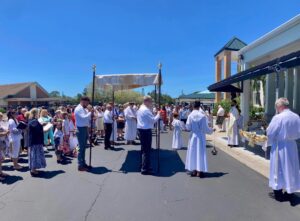 The canopy serves a dual purpose. On one hand, it protects the Blessed Sacrament against anything that might fall on it, including light rain, creating a “sacred space” that is reserved for the priest carrying the monstrance. Secondarily, the faithful in the large crowd can locate the Blessed Sacrament at the head of the procession more easily.
The canopy serves a dual purpose. On one hand, it protects the Blessed Sacrament against anything that might fall on it, including light rain, creating a “sacred space” that is reserved for the priest carrying the monstrance. Secondarily, the faithful in the large crowd can locate the Blessed Sacrament at the head of the procession more easily.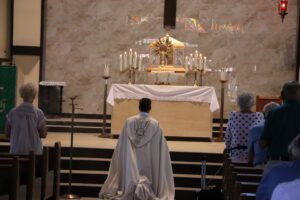

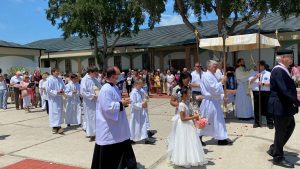 “The power of Our Lord, and His Presence in the Blessed Sacrament, brings me great comfort,” Dwyer said. “I feel so happy to be able to honor Jesus in this special way.”
“The power of Our Lord, and His Presence in the Blessed Sacrament, brings me great comfort,” Dwyer said. “I feel so happy to be able to honor Jesus in this special way.” The procession made its way from the main church into the Parish courtyard and then into the parking lot, stopping at four temporary altars where Father Scanlan led everyone in prayer and readings from the Gospel. The procession concluded in the Parish Chapel where Father led the Benediction.
The procession made its way from the main church into the Parish courtyard and then into the parking lot, stopping at four temporary altars where Father Scanlan led everyone in prayer and readings from the Gospel. The procession concluded in the Parish Chapel where Father led the Benediction.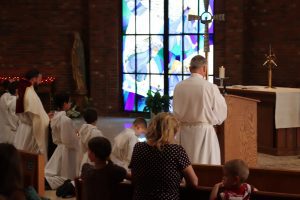 “Brothers and sisters, Our God dwells among us,” Father said during the Mass. “He comes to honor us. To strengthen and heal us… But, the Lord can only do so much, unless we open our hearts to Him. We can say Lord, help me to believe; help me to receive You with love and affection; help me to allow you to heal me and to transform me, this heart and soul of mine. He wants so much for us to encounter Him, here today, each one of us. Brothers and sisters, this Great Feast offers us the opportunity to rekindle our love and our wonder and our gratitude of the Presence of Jesus in the Blessed Sacrament. He is here. He is here.”
“Brothers and sisters, Our God dwells among us,” Father said during the Mass. “He comes to honor us. To strengthen and heal us… But, the Lord can only do so much, unless we open our hearts to Him. We can say Lord, help me to believe; help me to receive You with love and affection; help me to allow you to heal me and to transform me, this heart and soul of mine. He wants so much for us to encounter Him, here today, each one of us. Brothers and sisters, this Great Feast offers us the opportunity to rekindle our love and our wonder and our gratitude of the Presence of Jesus in the Blessed Sacrament. He is here. He is here.” The Feast Day is an important affirmation of our belief that Our Lord is really and truly sacramentally present in the form of bread and wine. When Our Lord instituted the Eucharist, He said this IS My Body and this IS My Blood; not this represents or is symbolic of my body and blood. The Sacrament was defined as “an outward sign” of inward grace given to us by Jesus Christ for our sanctification and salvation.
The Feast Day is an important affirmation of our belief that Our Lord is really and truly sacramentally present in the form of bread and wine. When Our Lord instituted the Eucharist, He said this IS My Body and this IS My Blood; not this represents or is symbolic of my body and blood. The Sacrament was defined as “an outward sign” of inward grace given to us by Jesus Christ for our sanctification and salvation.